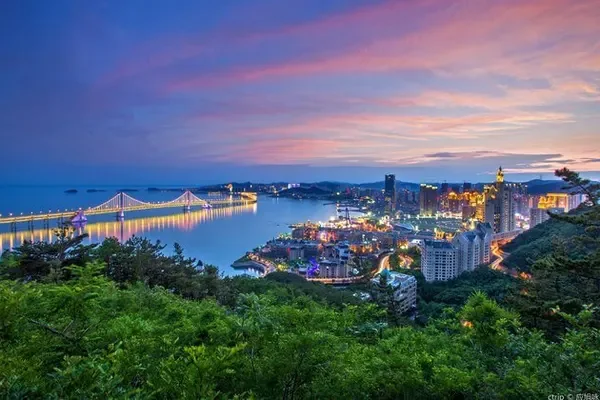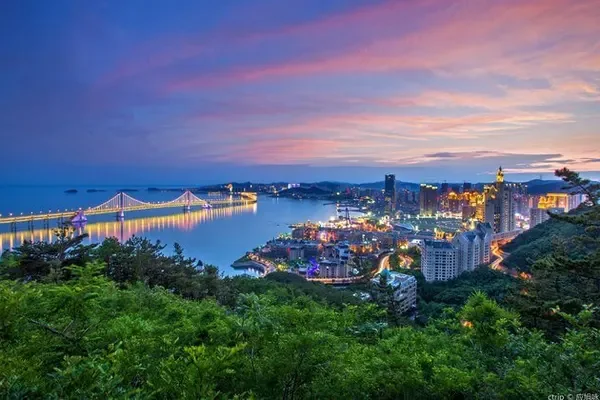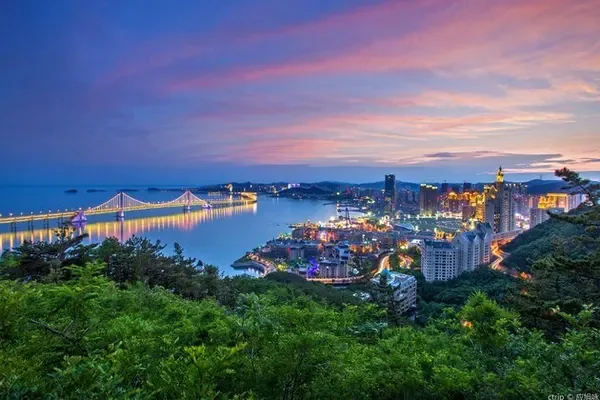The major events of the country lie in sacrifice and Rong.
The vernal equinox death day, the summer solstice festival,
The autumnal equinox worships the moon and the winter solstice worships the sky.
Therefore, the Temple of Heaven, Earth, Sun and Moon was built in Beijing.
The first three palaces, the last six palaces,
Glazed tiles, cinnabar walls, white marble,
Dragon totem, gilded brick floor, carved beams and painted buildings.....
The majesty of the royal family, the crape myrtle is in the middle,
The Forbidden City of the Emperor's Purple Palace - Forbidden City
1. Written in front - Old Beijing
I have been to many ancient capitals,
Xi'an, Luoyang, Nanjing,
In the end, I have different emotions towards Beijing,
Perhaps because the dynasty is closer,
Or maybe because it is the imperial capital of today.
from architecture to food,
Everyone can clearly count the numerous names:
Forbidden City Temple of Heaven and Old Summer Palace, Roast Duck with Soy Sauce and Noodles with Fried Sauce...
Then start with a bowl of soybean juice in this alley.
The uncle who just finished making soybean juice
2. Taste of Beijing - soybean juice
Yinsan Bean Juice started operation in 1997.
The owner of the shop was originally engaged in tobacco business,
After the failure, he was instructed by a neighbor who was a senior in soybean juice skills,
Opened a stall in my own building, because it is next to the vegetable market,
And the taste is highly praised and quickly recognized by the folks.
So far, it has moved 5 times before and after, and has always adhered to the original intention.
Keep the thickest taste of old Beijing soybean juice.
Awarded the "must recommend" restaurant in the Beijing Michelin Guide,
It still has the temperament of a vegetable market breakfast shop,
Fortunately, no change.
Small pickles with bean juice and burnt rings, the basic standard,
The small room is full of household items with a Beijing accent,
Just a minute ago, I was haggard from getting up early in winter,
At this moment, I have already been moved by this steaming life,
Sure enough, the most heart-warming is always the fireworks in this world.
Address: No. 176, Dongxiaoshi Street,
Open at 5:30 and close at noon.
Bean juice, burnt rings, sugar fire, braised meatballs
3. Temple of Heaven—Sacrifice
Yinsan Bean Juice is located near the North Gate of the Temple of Heaven.
After breakfast, I was with the grandpa and aunt who just sat opposite,
You can meet the Temple of Heaven inadvertently.
The major events of the country lie in sacrifice and Rong.
In ancient times, emperors all had the custom of offering sacrifices in four seasons, which was grand and rigorous.
The vernal equinox death day, the summer solstice to worship the land, the autumnal equinox to worship the moon, and the winter solstice to worship the sky.
The Temple of Heaven was built in the Yongle period of the Ming Dynasty.
Imitating the shape and system of Nanjing, it is called the Temple of Heaven and Earth.
During the Jiajing period, another Fangze (Ditan) was built in the northern suburbs.
Then the heaven and the earth will be divided into sacrifices.
It was rebuilt during the Qianlong and Guangxu periods of the Qing Dynasty.
Sign building - Hall of Prayer for Good Harvests
There are two walls built in the Temple of Heaven, which are divided into inner and outer altars, which are in the shape of Hui.
On the whole, the north corner is round.
The south corner is square, which means the sky is round and the place is round.
There are two altars in the north and south in the altar, separated by an altar wall in the middle.
In the north is the Prayer Valley Altar, and behind the altar is the Hall of Prayer for Good Harvests.
It was the tallest building in Beijing during the Ming and Qing Dynasties.
To the south is the Circular Mound, and the two altars are connected by the Danbi Bridge.
The south of the bridge is an echoing wall, talking against the wall,
The sound wave refracts along the wall and travels to the other end,
legible.
With the Pujiu Temple Pagoda in Puzhou, Shanxi,
Henan Sanmenxia Toad Tower,
Shiqin in Dafo Temple, Tongnan County, Chongqing
Collectively known as the four echo buildings in China.
Today, the North Gate of the Temple of Heaven is the North Gate of the outer altar wall.
How to identify the inner altar wall?
When you need to buy a second ticket to enter the Hall of Prayer for Good Harvests, you are already at the inner altar.
Circular mound surrounded by white marble
4. Forbidden City - Forbidden City
The Forbidden City, in the middle of Ziwei, is the forbidden area of the Purple Palace where the Emperor of Heaven lives.
It was built after Zhu Di moved his capital to Beijing, which lasted 14 years.
The first three halls, the last six halls, glazed tiles, cinnabar walls, white marble,
Dragon totem, gilded brick floor, carved beams and painted buildings.....
All show the grandeur of the royal family.
Climbing up the steps to the Golden Temple,
This is the largest and most top-level wooden structure building in China.
Witnessed 24 emperors of the Ming and Qing dynasties,
In less than 300 years, it has experienced 4 times of thunder and fire destruction,
During the four reconstructions, it was repeatedly reduced,
Finally survived the smoky war,
It should be the favor of God and the blessing of the ancestors
Let us see its glory again today.
The palace wall of the Forbidden City is 12 meters high and has a circumference of about 3.4 kilometers.
It forms a rectangular city pool with a moat outside the wall.
The river is about 50 meters wide.
It consists of two parts: the outer dynasty and the inner court.
The Outer Dynasty centered on the Hall of Supreme Harmony, the Hall of Central Harmony, and the Hall of Preserving Harmony.
There is Wenhua Hall in the east and Wuying Hall in the west as two wings.
It is the place where the imperial court held grand ceremonies.
Behind the outer court is the inner court,
There are Qianqing Palace, Jiaotai Hall, Kunning Palace, and Imperial Garden
And the East and West Sixth Palaces,
It is the emperor who handles daily government affairs
And where they lived with the concubines.
Ningshou Palace area on the east side,
It was the place where Emperor Qianlong of the Qing Dynasty abdicated for the retirement of the Supreme Emperor.
Forbidden City Red Wall (Palace Wall)
5. City gates and buildings - Meridian Gate
The Meridian Gate, the main entrance of the Forbidden City, and the Jinan Gate.
The east, west and north sides are connected by a 12-meter-high city platform.
Surrounded into a square square.
There are halls and towers built on the city tower.
It is the highest peak in the palace group of the Forbidden City.
The Meridian Gate is the place where the emperor issued edicts and ordered expeditions.
The main entrance in the middle is dedicated to the emperor.
The queen can enter once when the emperor is married.
The number one scholar, the second place, and the third flower in the palace examination,
Three people can go out from this door once.
Ministers of civil and military affairs enter and exit the east door, and clan princes enter and exit the west door.
Meridian Gate Square
Shenwumen was originally called Xuanwumen, and Xuanwu was in the north.
The north palace gate of the emperor's palace is often named Xuanwu.
Later, it was changed to Shenwumen to avoid the taboo of Kangxi's name.
Shenwumen is the highest level
The form of the city gate tower with double eaves and hipped roof,
The shape is one level lower than the Meridian Gate.
In ancient times, it was the access control for daily access to the palace.
It is now the main entrance of the Palace Museum.
The Donghua Gate is opposite to the Xihua Gate, with the same shape and structure.
There is a dismounting stele outside the gate, and the Jinshui River winds through the gate.
There are five stone bridges in the middle of the river.
Jinshui River
6. The imperial gate listens to the government - the gate of Taihe
Enter the Meridian Gate to enter the outer court area,
The Outer Dynasty is the place where the emperor handles political affairs.
There are three main halls: the Hall of Supreme Harmony, the Hall of Zhonghe, and the Hall of Preserving Harmony.
The abutment of the main hall overlaps in three layers and is made of white marble.
It is 8 meters high and has an I-shape.
The edge of the platform is carved with white marble,
Lookout posts and dragon head decorations,
A dragon is engraved in the middle of the abutment, set off by waves and clouds.
Under the balustrades and at the faucets of the pillars,
Each is carved with a hole,
When the rainwater is abundant, the rainwater on the three-story abutment is discharged layer by layer through the small holes, and then flows out through the faucets.
In addition to the luxurious decorative function, it is also a drainage system.
Majestic white marble abutment
The Gate of Supreme Harmony, the main entrance of the outer palace,
The largest palace gate in the Forbidden City.
Built in the Yongle period of the Ming Dynasty, it is called Fengtianmen.
During the Jiajing period, it was renamed Huangjimen, and in Shunzhi of the Qing Dynasty, it was changed to Taihemen.
The square in front of the gate is about 26,000 square meters,
From the Ming Dynasty to the early Qing Dynasty, it was the Yumen Hearing Office, and later it was changed to Qianqingmen.
Gate of Supreme Harmony
7. The Hall of Supreme Harmony——Jinluan Hall
The Hall of Supreme Harmony, commonly known as the Hall of Golden Luan,
It was built during the Yongle period of the Ming Dynasty and is called Fengtian Temple.
During the Jiajing period, it was renamed the Huangji Hall, and in the Shunzhi period of the Qing Dynasty, it was changed to the Hall of Supreme Harmony.
It is the place where the emperor holds a grand ceremony.
After its completion, it was repeatedly destroyed and rebuilt.
The existing one is the rebuilt shape in the Kangxi period of the Qing Dynasty.
It is 11 rooms wide and 5 rooms deep, and is 35 meters high together with the platform base.
Covering an area of more than two thousand square meters, it is the largest palace in the Forbidden City.
A total of 24 emperors of the Ming and Qing Dynasties held their enthronement,
Major ceremonies such as wedding ceremonies, canonization of the queen, and commanding generals to go to war,
At that time, thousands of people shouted long live three times, and hundreds of ritual instruments and bells and drums rang together.
Extremely royal style.
In addition, the annual Longevity Festival (Emperor's birthday),
New Year's Day (first day of the first lunar month) and winter solstice, three major festivals,
Here the emperor accepts congratulations from civil and military officials.
And give banquets to princes and ministers.
The main hall of the Hall of Supreme Harmony (dragon chair)
Behind the Hall of Supreme Harmony is the Hall of Central Harmony.
Before the ceremony in the Hall of Supreme Harmony,
Cabinet ministers and officials from the Ministry of Rites saluted the emperor in the Hall of Central Harmony,
The emperor can take a rest or conduct ceremonial exercises here.
Before offering sacrifices to Heaven and Earth and the Ancestral Temple, review the sacrificial texts here.
Before going to Zhongnanhai (Royal Garden) to practice farming,
Check out the tillage tools here.
After the Hall of Central Harmony is the Hall of Preserving Harmony.
Every year on New Year's Eve, the emperor gives a banquet here to the princes of foreign vassals.
It is also the examination room for the imperial examination.
outside door of hall
8. Inner Court - Harem
The second half of the Forbidden City building is called the inner court.
Pass the Qianqing Gate with glazed screen walls on the left and right,
Inside the door is the Housan Palace.
The inner court is centered on Qianqing Palace, Jiaotai Palace, and Kunning Palace.
There are East Sixth Palace and West Sixth Palace on the east and west wings, and there is an imperial garden behind.
It is the place where the emperor handles daily government affairs and the living area where the concubines live.
There are warm pavilions at both ends of Kunning Palace.
From the Ming Dynasty to the Qing Emperor Yongzheng, it was the queen's bedroom.
Dongnuange is the bridal chamber of the emperor's wedding.
The three emperors Kangxi, Tongzhi and Guangxu all held their weddings here.
Later it became a place of worship,
After Yongzheng, Xinuange was the sacrificial place for shamans.
Qionghua Zhaobi
9. Jingshan—Royal Garden
Jingshan is an artificial mountain built to create Fengshui in the imperial city.
It is formed by excavating the moat and the silt of the South Lake,
Satisfy the principle of negative yin in the imperial city,
At the same time, it suppresses the Fengshui of the previous dynasty, so it is also known as Zhenshan.
During the Ming and Qing Dynasties, fruit trees were planted all over the garden, and animals such as deer and cranes were raised.
The foot of the mountain was once named Baiguoyuan, and the mountain was Long Live Mountain.
During the Shunzhi period of the Qing Dynasty, it was renamed Jingshan, which means tall and admirable.
Jingshan Park is located on the central axis of Beijing City.
Across the street from Shenwumen of the Forbidden City, it is the highest point in Beijing.
The top of the hill overlooks the whole city.
snow falls in the Forbidden City
At the end of Ming Dynasty, Li Zicheng's rebel army invaded Beijing,
Chongzhen Zhu Youjian fled to Jingshan, feeling ashamed of his ancestors' foundation,
He committed suicide with a belt on the locust tree with crooked neck under Guanmiao Pavilion.
During the ten-year turmoil, the old pagoda trees were cut down as the four olds.
In 1981, it was newly transplanted at the original site,
In 1996, the 150-year-old ancient pagoda tree was transplanted here for the second time.
The majestic Longevity Mountain is densely connected with smoke trees;
In hope of the soul of the emperor, I don't know where to cry.
Panoramic View of the Forbidden City from Jingshan
10. Other related - Tips
1. Tickets to the Forbidden City: 60 yuan in peak season, 40 yuan in off-season, 10 yuan each for the Clock and Watch Museum and the Treasure Museum.
2. It’s noon after walking around the Temple of Heaven. For lunch, you can consider Siji Minfu next to the Forbidden City. In the eyes of the locals, it is a roast duck restaurant that is better than Quanjude. The chain store has no advantage in price, and the overall environment and taste are commendable.
3. After going to Yinsan Douzhi, I realized that not all stores in Beijing are expensive, and the daily breakfast price here is similar to other cities.
4. It is easy to take pictures of the Temple of Heaven and the Forbidden City. If the sky is clear and the weather is clear, pressing the shutter at any corner will be pleasing to the eye.
5. Ten years ago, the Hall of Supreme Harmony in the Forbidden City could still be entered, but now it can only be viewed from a distance through the railings. What has not changed is that there are still many people, many teams, many tour guides and commentators. If you want, you can basically hear the explanations of different people in front of different buildings, so half a day passed.
6. For dinner, you can consider old Beijing’s broiled pork and lamb scorpion. There are many places to go at night, such as Houhai, Sanlitun's bars and night scenes.
Four Seasons Minfu Roast Duck
There are no strangers in the rivers and lakes, but they have never met each other
Thanks to each of you for being lovely and taking the time to read.
One wine, one Jianghu, one person, one life.
If I happen to meet you, unfortunately, I am waiting for you.
Life|Travel|Gourmet|City|Hanfu
Traveling thousands of rivers and mountains, this is Chongqing



